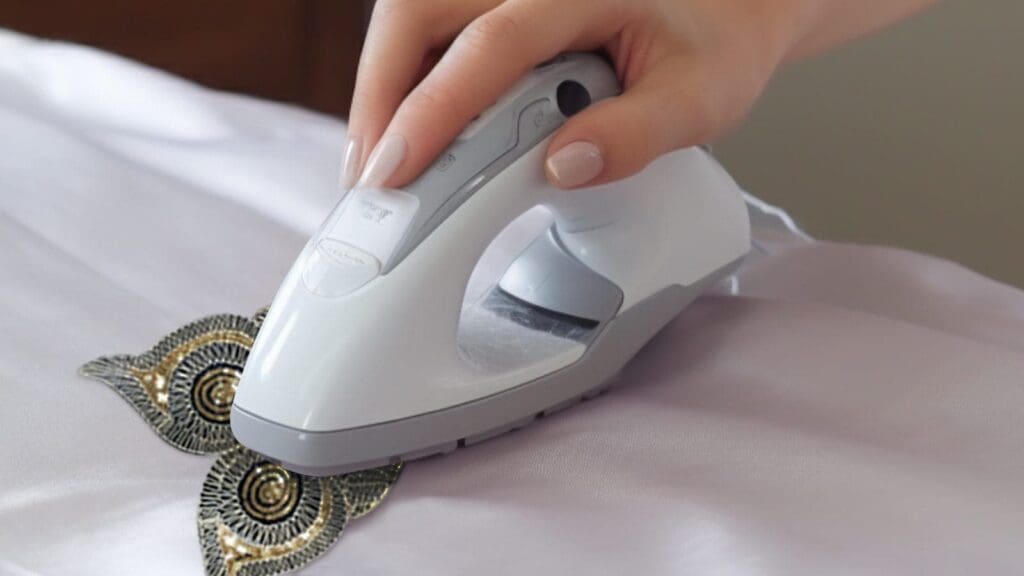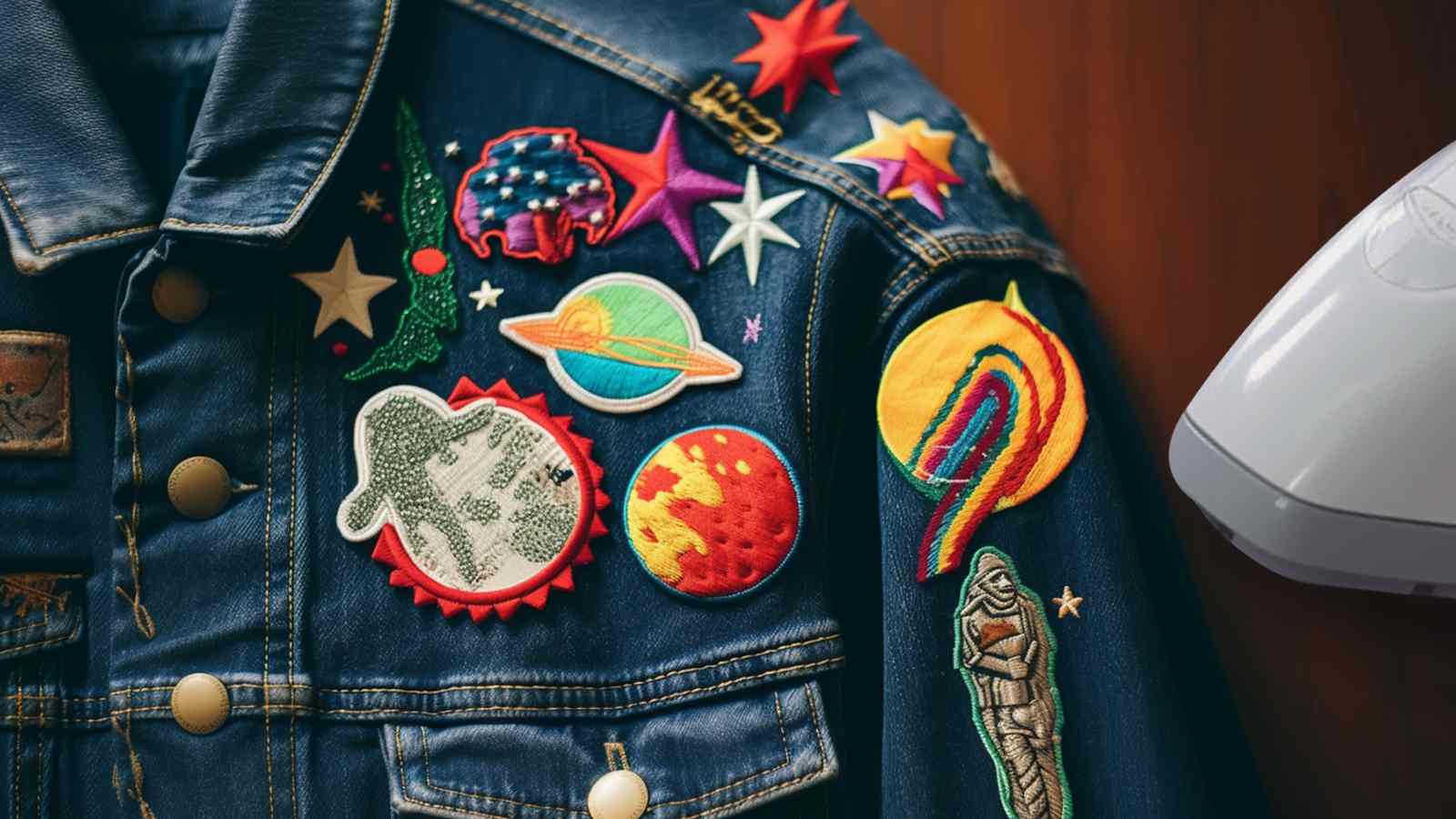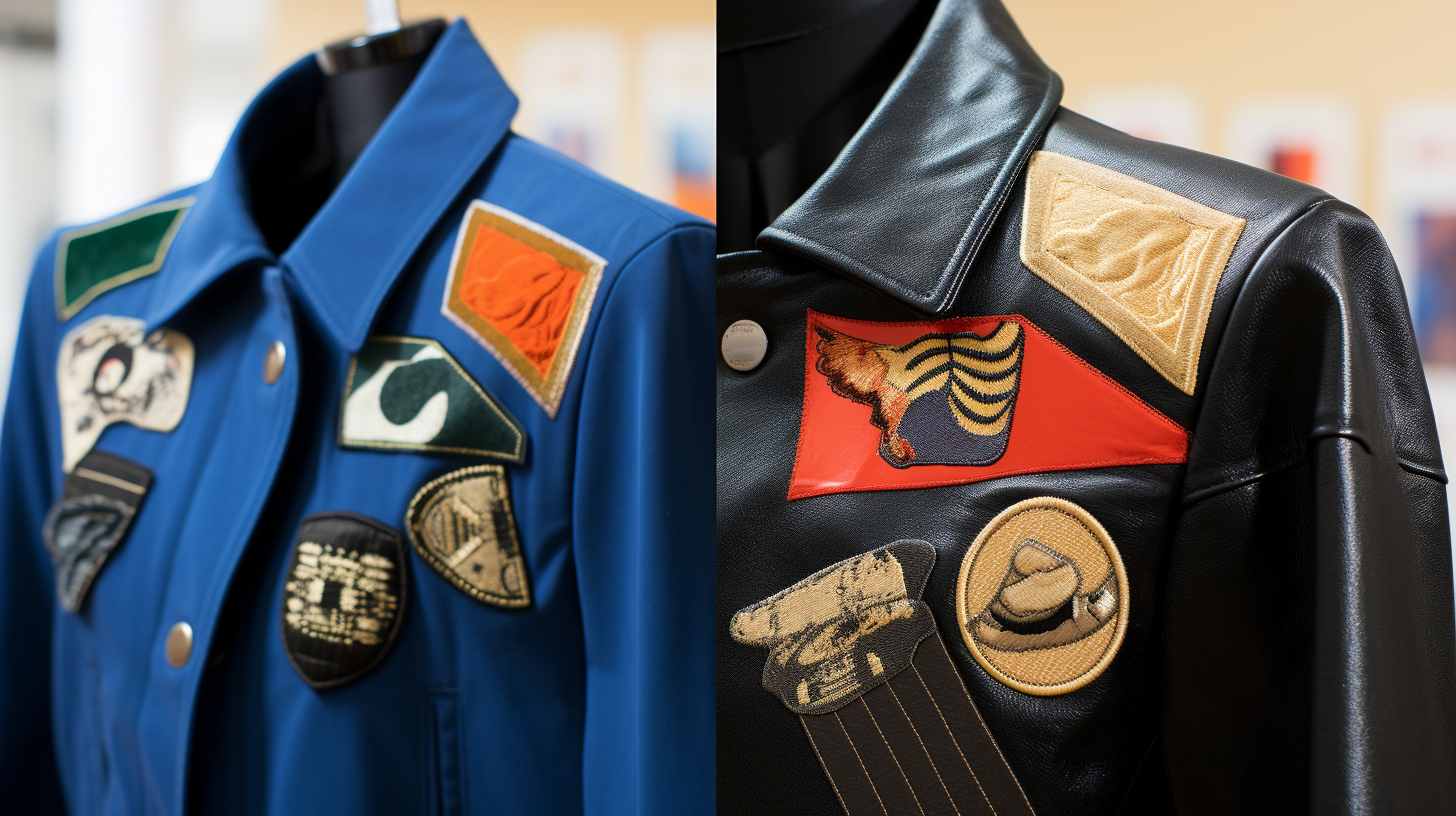You’re at a crossroads with needle and thread in one hand and an iron in the other—patches in hand, it’s time to choose your path.
Iron on vs. sew on patches: what’s the better choice between the two types of patches?
Iron-on patches tempt you with simplicity. It’s a perfect quick fix for the on-the-go individual. Yet, they may not hold up to frequent wear or washing rigors. Sew-on patches need time and a steady hand. But they promise endurance and a personalized touch to your garments.
Weighing the pros and cons, you’ll decide based on the longevity you need and the effort you’re willing to put in. It’s not just about attaching a patch. It’s about matching your lifestyle to the method of application.
What’s the Better Choice? Iron on or Sew on Patches?
When deciding whether to sew on a patch or iron it on, you must consider the garment’s material, its intended longevity, and your skill level.
An iron-on patch offers convenience, as it doesn’t need sewing skills. You can quickly attach it to your fabric. But sew-on patches are more durable. They can withstand washes and wear better, especially for high-wear items.
Let’s weigh the pros and cons: Iron on vs. sew. An iron-on is less labor-intensive but may peel off sooner. In contrast, sewing ensures a stronger bond, yet you’ll need some sewing prowess.
Iron on vs. Sew on Patches: A Thorough Guide to Iron on Patches
What are Iron on Patches?

Iron-on patches are an embellishment you can attach to your fabric with heat-activated adhesive on the back of the patch.
The heat from the iron activates the adhesive, which causes it to bond with the fabric, securing the patch in place.
How do Iron on Patches Work?

First, you’ll place the patch on the garment in the desired location.
Then, you’ll place a pressing cloth over the patch to protect both the patch and the fabric from direct heat.
Next, with the iron set to a hot setting (usually indicated for cotton), you’ll press down firmly over the patch area for a recommended amount of time. The heat activates the adhesive, causing it to become tacky and adhere to the garment.
Once it cools, the patch should be securely attached, thanks to the melted glue now fused with the fabric.
Advantages of Iron-on Patches

You’ll appreciate the simplicity of iron-on patches if you’re pressed for time or lack sewing expertise. They’re designed for quick application, easily adhering to your garment with a heated iron.
Plus, they’re ideal for small designs that don’t demand the durability of sewn edges.
Quick and Easy to Use
Iron-on patches’ standout advantages are that they’re easier to apply. They need only a few minutes and a hot iron to adhere securely to your fabric.
No Sewing Skills Needed
Anyone can effortlessly apply an iron-on patch, as it doesn’t need any sewing expertise. This means you’re free from the hassle of threading needles or mastering complex stitches. You won’t need any special tools beyond what you likely already have at home—a standard iron and an ironing board.
These patches are perfect for a quick fix or a swift update to your wardrobe or accessories. They’re especially handy when you’re in a pinch for time, providing a secure attachment in mere minutes. Whether you’re sprucing up a bag or customizing a jacket, iron-on patches make it a breeze.
Suitable for Small Patches
Iron-on patches are an ideal choice for small embellishments. They adhere quickly and smoothly to your garments without intricate stitching. You’ll find they’re especially handy when you want to add a bit of flair to your outfit but don’t have the time or expertise for needlework.
Disadvantages of Iron-on Patches
When you opt for iron-on patches, remember that they generally offer less longevity than their sewn counterparts. They often peel away after some washes. If you’re debating iron on patches vs. sew on patches for durability, iron-on patches, while convenient, may not stand the test of time.
They usually last through about 25 washes before the adhesive begins to weaken. This could result in the edges lifting, eventually leading the patch to come off entirely.
Iron on vs. Sew on Patches: A Thorough Guide to Sew on Patches
What are Sew on Patches?

You’ll find sew-on patches are a more traditional option, requiring a needle and thread to attach them securely to your fabric. These patches are made of fabric and thread, blending like regular fabric once you put patches on your items.
When you sew on patches, you ensure they’ll stay put even after you wash them in cold water many times. This method is particularly favored for items with a lot of wear and tear.
How do Sew on Patches Work?

To apply sew-on patches, you need to thread a needle and stitch them directly onto the fabric, ensuring a secure and permanent attachment. This method is particularly effective for items you need to wash frequently. Unlike iron-on patches, sew-on patches work by physically binding the patch’s fabric to your garment with thread, which means they can endure the rigors of both hot and cold water cycles.
The durability of the sewn bond makes sew-on patches ideal for high-wear areas. Whether fixing a tear, adding a personal touch to your backpack, or customizing your jeans, sewing on a patch gives you the flexibility and strength that other methods lack.
Advantages of Sew-on Patches

You’ll find sew-on patches offer a more durable solution for your garments, especially when dealing with high-wear items like denim jackets or backpacks. They ensure a long-lasting hold that matches the rigors of daily use and frequent washes.
If you’re looking for a patch that’s meant to last, sewing it on is the way to go.
More Durable
Over time, you’ll find that sew-on patches offer superior durability, maintaining their hold through countless washes and daily wear. Unlike their iron-on counterparts, sewn patches form a strong bond with the fabric that isn’t easily weakened by the rigors of life.
This means they’re less likely to fray or come loose, even when you’re constantly moving or washing your clothes. Plus, the strength of the stitches ensures the patch stays secure, so you won’t have to worry about it peeling off like some iron-on patches might.
For items you love and wear often, sewing patches is the way to keep your style intact for the long haul.
Long-lasting Hold
When you choose a sew-on patch, you’re investing in a long-lasting hold that’s designed to endure through wear and frequent laundering. Unlike iron-on patches, which may peel or come loose over time, sewn patches are firmly anchored to the fabric by threads.
This means they’re less likely to fray or unravel, maintaining their appearance and integrity even after many wash cycles. You’ll find that sewing the patches creates a bond strong enough to withstand the rigors of daily use, be it on a rugged backpack or your favorite pair of jeans.
Suitable for High-Wear Items
If you’re considering patches for items that undergo a lot of wear and tear, sew-on patches are your best bet for enduring quality. Unlike their iron-on counterparts, these patches are designed to withstand the rigors of daily use.
Whether you’re looking to customize your favorite pair of jeans or enhance the durability of a well-loved backpack, sew-on patches provide a reliable solution. They’re not only for those with sewing prowess. Anyone can apply them with a bit of patience and a simple needle and thread.
You’ll find that the extra effort pays off with a bond that lasts through thick and thin, ensuring your patch stays put no matter what challenges come its way.
Differences Between Iron-on and Sew-on Patches

When staring at that jacket you want to customize, you’re likely wondering what sets iron-on patches apart from sew-on patches.
The critical differences between iron on and sew on patches are the attachment method, the bond’s strength, and whole durability.
Attachment Method
On the attachment method, you’ll find that iron-on patches adhere to fabric through heat-activated glue. Sew-on patches need stitching to secure them in place.
Iron-ons offer a convenient shortcut: position your patch, apply heat with an iron, and the glue melts to create a bond. It’s a great fix if you’re short on time or lack sewing expertise. But there’s a trade-off: this bond can weaken with wear and washing, potentially making your patch less secure over time.
Sew-on patches, by contrast, demand a bit more effort. You’ll need a needle and thread to stitch your patch onto the fabric. This method is more labor-intensive but results in a stronger, more lasting attachment. It’s ideal for items that undergo frequent use or laundering.
Bond’s Strength
After considering the ease of attachment, it is crucial to examine how iron-on patches usually offer a less robust bond than their sewn-on counterparts. The heat-activated glue of iron-on options can weaken over time, especially with repeated exposure to heat, moisture, and friction. That’s why they’re more suited for items that won’t need much rough use.
In contrast, sew-on patches boast a much stronger bond due to the durability of the stitching. They stay even on high-wear items like your favorite jeans or a trusty backpack. So, sewing is the way to go if you want a more permanent fix.
Durability
While iron-on patches may seem convenient, they often last only about 25 washes before the adhesive begins to fail. Sew-on patches, once stitched, offer a more enduring bond to your garments. Sew on patches ensure they’re tightly integrated with the fabric, preventing them from falling off even with frequent use or laundering.
Conversely, iron-on patches may peel or fray over time, especially if the item is washed or worn regularly. If you’re looking for a long-term solution for your favorite jacket or backpack, sew-on patches are the way to go. They’re less likely to unravel, giving your items a durable, customized look that matches everyday life’s rigors.
Conclusion
You’ve weighed your options—iron-on for ease and speed, sew-on for durability and craft.
Iron-ons are quick fixes, but beware of wash cycles; they mightn’t stick around. Sew-ons need effort but promise longevity and a personal touch.
It’s your call: stress convenience or embrace the sewing challenge.
Whatever you choose, make your jacket a statement that genuinely suits your lifestyle and your commitment to your unique style. Happy customizing!





